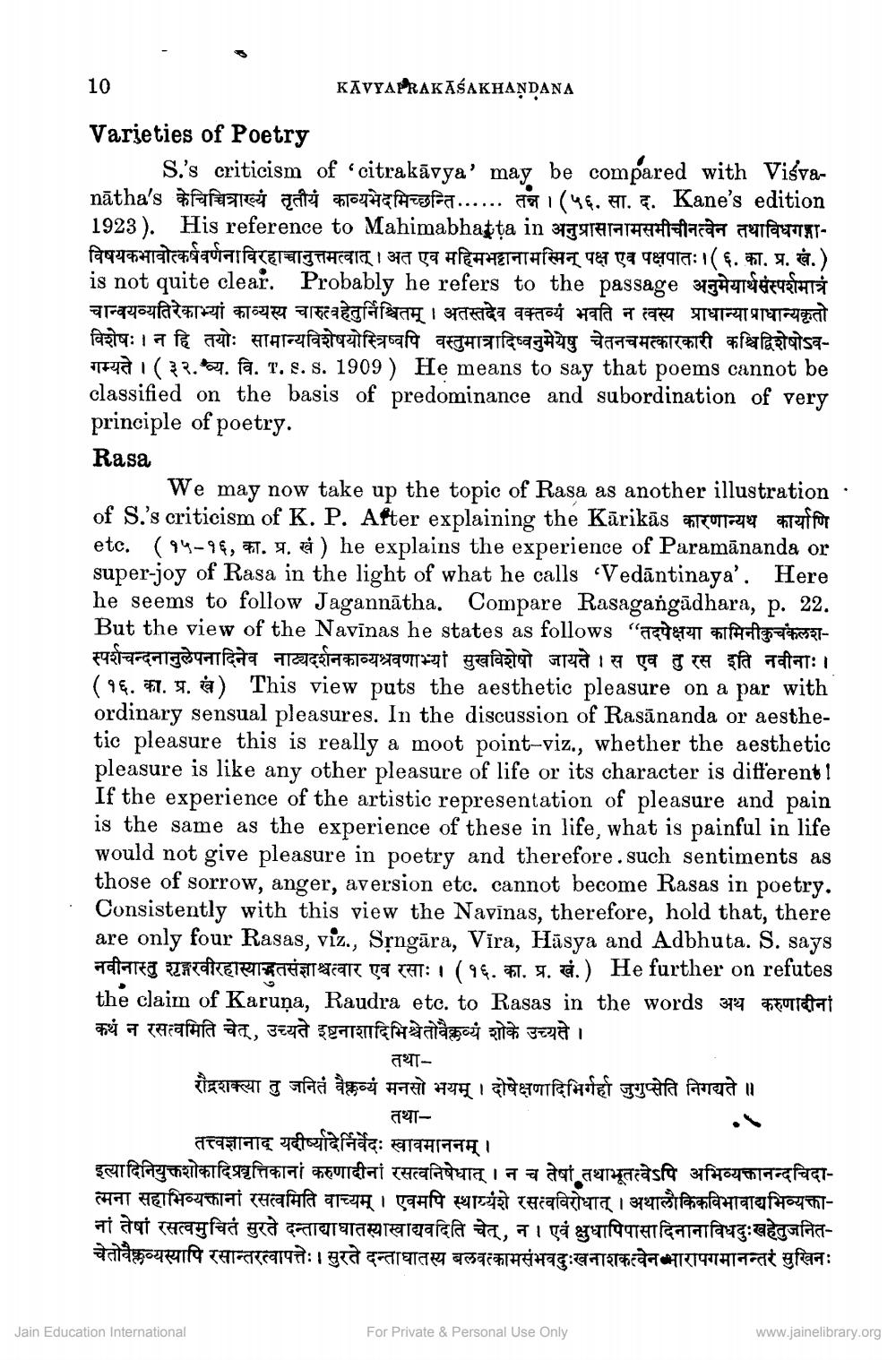________________
10
KAVYAPRAKĀŠAKHANDANA
Varieties of Poetry
S.'s criticism of 'citrakāvya' may be compared with Visvanātha's केचिच्चित्राख्यं तृतीयं काव्यभेदमिच्छन्ति...... तन्न । (५६. सा. द. Kane's edition 1923). His reference to Mahimabhatta in अनुप्रासानामसमीचीनत्वेन तथाविधगङ्गाविषयकभावोत्कर्षवर्णनाविरहाच्चानुत्तमत्वात् । अत एव महिमभट्टानामस्मिन् पक्ष एव पक्षपातः । (६. का. प्र. खं.) is not quite clear. Probably he refers to the passage अनुमेयार्थसंस्पर्शमात्रं चान्वयव्यतिरेकाभ्यां काव्यस्य चारुत्वहेतुनिश्चितम् । अतस्तदेव वक्तव्यं भवति न त्वस्य प्राधान्याप्राधान्यकृतो विशेषः । न हि तयोः सामान्यविशेषयोस्त्रिष्वपि वस्तुमात्रादिष्वनुमेयेषु चेतनचमत्कारकारी कश्चिद्विशेषोऽवगम्यते । (३२. व्य. वि. ''. s. S. 1909) He means to say that poems cannot be classified on the basis of predominance and subordination of very principle of poetry. Rasa
We may now take up the topic of Rasa as another illustration : of S.'s criticism of K. P. After explaining the Karikās कारणान्यथ कार्याणि etc. (१५-१६, का. प्र. खं) he explains the experience of Paramānanda or super-joy of Rasa in the light of what he calls Vedāntinaya'. Here he seems to follow Jagannātha. Compare Rasagangādhara, p. 22.
But the view of the Navinas he states as follows “तदपेक्षया कामिनीकुचकलशस्पर्शचन्दनानुलेपनादिनेव नाट्यदर्शनकाव्यश्रवणाभ्यां सुखविशेषो जायते । स एव तु रस इति नवीनाः। (१६. का. प्र. ख) This view puts the aesthetic pleasure on a par with ordinary sensual pleasures. In the discussion of Rasānanda or aesthetic pleasure this is really a moot point-viz., whether the aesthetic pleasure is like any other pleasure of life or its character is different ! If the experience of the artistic representation of pleasure and pain is the same as the experience of these in life, what is painful in life would not give pleasure in poetry and therefore.such sentiments as those of sorrow, anger, aversion etc. cannot become Rasas in poetry. Consistently with this view the Navīnas, therefore, hold that, there are only four Rasas, viz., Sșngāra, Vira, Hāsya and Adbhuta. S. says नवीनास्तु शृङ्गरवीरहास्यानतसंज्ञाश्चत्वार एव रसाः । (१६. का. प्र. खं.) He further on refutes the claim of Karuna, Raudra etc. to Rasas in the words अथ करुणादीना कथं न रसत्वमिति चेत् , उच्यते इष्टनाशादिभिश्चेतोवैक्लव्यं शोके उच्यते।
तथारौद्रशक्त्या तु जनितं वैलव्यं मनसो भयम् । दोषेक्षणादिभिर्गर्दा जुगुप्सेति निगद्यते ॥
तथातत्त्वज्ञानाद् यदीर्ध्यादेर्निर्वेदः स्वावमाननम् । इत्यादिनियुक्तशोकादिप्रवृत्तिकानां करुणादीनां रसत्वनिषेधात् । न च तेषां तथाभूतत्वेऽपि अभिव्यक्तानन्दचिदात्मना सहाभिव्यक्तानां रसत्वमिति वाच्यम् । एवमपि स्थाय्यंशे रसत्वविरोधात् । अथालौकिकविभावाद्यभिव्यक्तानां तेषां रसत्वमुचितं सुरते दन्ताद्याघातस्यास्वाद्यवदिति चेत्, न । एवं क्षुधापिपासा दिनानाविधदुःखहेतुजनितचेतोवैक्लव्यस्यापि रसान्तरत्वापत्तेः । सुरते दन्ताघातस्य बलवत्कामसंभवदुःखनाशकत्वेन भारापगमानन्तरं सुखिनः
.
Jain Education International
For Private & Personal Use Only
www.jainelibrary.org




